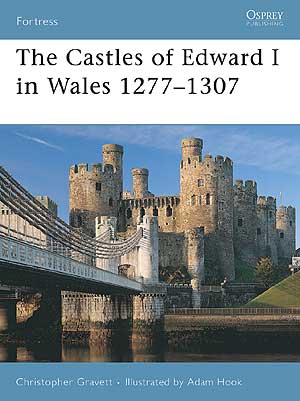
De Re Militari | Book Reviews
Christopher Gravett
The Castles of Edward I in Wales 1277-1307
Fortress 64. Osprey, 2007. 64pp. ISBN-13: 978-1846030277. $16.95/£11.95.

From the ever popular Osprey formula comes the sixty-fourth in their Fortress series, a user-friendly guide to the Welsh castles of King Edward I of England. Christopher Gravett and Adam Hook do an excellent job of illustrating, through words and artwork, the substantial military, social and historical (not to mention touristic) importance of Edward I’s castles in Wales.
In 1277, after the success of Edward’s first Welsh campaign a vast castle-building programme was begun in order to “assert his lordship” and strengthen Edward’s powerbase in Wales. This included the building of new castles, expanding or replacing old castles and the creation of planned and walled towns. A brief outline of the background and events of the Welsh campaigns is given in the short introduction to the book, as well as a very helpful placement map and a detailed chronology. Although clearly not the focus of the book, a bit more on the strategy and policies of Edward’s castle-building in Wales could certainly benefit the introduction, if for nothing more then to help answer the question of ‘why,’ as it does so beautifully with the question of ‘how.’
The main part of the book begins with the design and development of the Welsh castles, highlighting the magnitude of the construction and with a good focus on the influences from Savoy and Constantinople. Towns, lordship castles, and Welsh castles are discussed separately in this section. The next chapter is devoted to the “principals of defense” concentrating on the various aspects of the castle walls, but with special attention paid to certain developmental features such as large gatehouses and turning bridges. A “tour” of Caernarfon castle is perhaps one of the most exciting features of the book as it allows Gravett to go more in depth on one of Edward’s most impressive and intriguing castles. Designed by the great Master James of St. George, but not built by him and so lacking in many of the Savoyard touches present in other castles, Caernarfon was a castle fit for an emperor and modeled after Constantinople. The “tour” of Caernarfon is very detailed and if not for the many photographs and illustrations it would be easy for the reader to get quite lost. But thankfully, in the Osprey tradition, the pictographic additions to Gravett’s descriptions make for an enjoyable and informative chapter.
The discussion of life in the castles is a nice departure from the rest of the book which is (rightly) campaign-centric. The chapter serves as a reminder that these fortresses were ultimately built to be lived in, and relative comfort was of practical importance. Features such as wells, chapels, workhouses and kitchens were as vital to the castle as strong curtain walls and arrow loops. This chapter is particularly interesting because it highlights some of the internal buildings that would have existed in the castles but have since disappeared. Again, Hook’s artistic recreations do much to clarify and enhance the written account. The subsequent chapter gives an overview of the successes, and later failures, of the castles at war. Edward’s castles were so well designed and constructed and of such lasting strategic importance that they continued to play in and withstand sieges through the War of the Roses. But, as Gravett points out, they could not withstand the improved gunpowder of the 17th century. The last section of the book is dedicated to a satisfying explanation of the ruinous state that many of Edward’s Welsh castles are found in today, aptly titled “Aftermath.” There is included a section on visiting the castles today and a glossary which is indispensable for those unfamiliar with castle-building and architectural terms. The bibliography is well rounded; further reading on Edward’s Welsh castles and campaigns can be found in the works of Taylor, Prestwich and Morris.
The book is relatively clear of errors and anecdotal stretching. As is usual for the Osprey series, there are no footnotes which can be of some frustration to the historian but would indeed hinder the quick pace of the book. Other than that, its value as a reference, especially to beginning students and non-academics, is definite. The photographs, artwork and detailed attention to major sites make for a great introduction to the castles of Edward I in Wales.

Victoria Bandt
Independent Scholar <[email protected]>
Page Added: March 2008